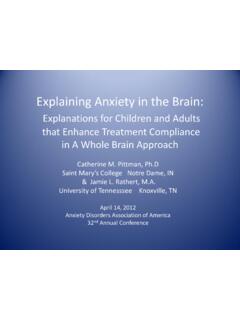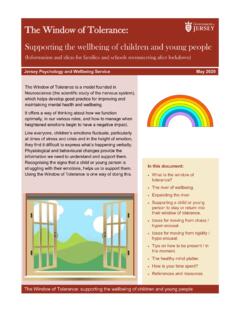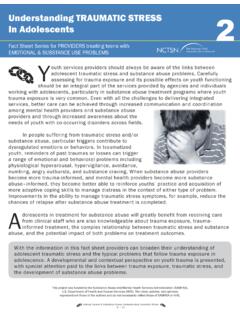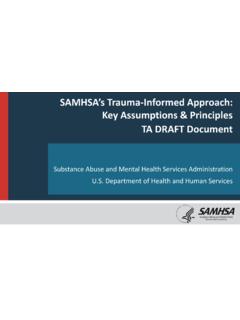Transcription of BE FEARLESS BE KIND: AN EMPATHY TOOLKIT - Hasbro
1 BE FEARLESS BE kind : AN EMPATHY TOOLKITB rought to you by: Ashoka s Start EMPATHY Initiative in collaboration with generationOn, generously sponsored by the Hasbro children s FundINTRODUCTIONThe World is challenges are increasingly complex. How are we preparing our children for this world of change? In this new environment, the skills of EMPATHY and kindness matter more than ever. EMPATHY and kindness help us build authentic relationships, understand problems through the perspectives of others, and create meaningful solutions. The faster we master EMPATHY and kindness, the faster we can shape a world where problems no longer outrun school is s time for our education system to catch up to these new realities. This is why the Hasbro children s Fund, generationOn and Ashoka s Start EMPATHY Initiative -- a global collaboration of social entrepreneurs, educators, parents and students working to make EMPATHY as essential as reading and math in education -- have created this TOOLKIT for TOOLKIT is powered by the expertise and experiences of Start EMPATHY s network of Ashoka Changemaker Schools -- over 200 schools around the world who are practicing changemaker education in their curricula and culture by distinctively cultivating EMPATHY , leadership, creative problem solving, and teamwork in their students.
2 The activities in this TOOLKIT will help teachers 1) Build the Foundation for EMPATHY and kindness in and out of the classroom, and 2) Activate EMPATHY and Kindness with specific activities that can be done in class and at practicing and prioritizing EMPATHY and kindness in our homes, schools, and communities, we hope to build a future where every young person is on a journey of becoming an empathetic is EMPATHY ? EMPATHY is the little-known giant. EMPATHY is hardwired into our brain and when harnessed, plays a crucial role in innovation, changemaking, and solving systemic problems. The textbook definition of EMPATHY is the ability to understand what someone is feeling, but when put into practice, EMPATHY means so much more:It means being able to grasp the many sides of today s complex problems and the capacity to collaborate with others to solve them; it means being as good at listening to the ideas of others as articulating your own; it means being able to lead a team one day, and participate as a team member the EMPATHY expands our social imagination beyond our own direct experience.
3 It is what gives us the will and the tools to be effective changemakers. EMPATHY in action is foundational in our ability to resolve conflict and make decisions with no precedents and drive positive is it Important?We hear a lot about grit, determination and perseverance. But those are all about me, the individual. EMPATHY means looking up from your desk, looking around you at others, and taking ownership for the community you are in -- whether it s a classroom, a neighborhood, a country or a planet. Our conviction is that in a world defined by connectivity and change, EMPATHY is a key currency. If we want a society or a world of changemakers, where problems no longer outrun solutions, then we have to prioritize EMPATHY because changemaking is EMPATHY in What is EMPATHY ? We asked some students at PS in the Bronx what EMPATHY meant to them. Here are their answers. Bren Brown on EMPATHY EMPATHY Helps Students From the Making Caring Common Project Higher engagement Higher academic achievement Stronger and more positive classroom community Stronger communication skills Lower likelihood of bullying behavior Less aggressive behaviors and emotional disorders More positive relationshipsBUILD THE FOUNDATIONC hildren learn EMPATHY when they are in an environment that helps them understand the perspectives of others and how to act accordingly.
4 These environments include:1. Supportive relationships: enabling children to act with kindness requires building strong relationships between children and teachers. This blog post and video from Momentous Institute shares how to make vision statements with your students and their Modeling: children learn by observation and gain insight on how to interact with others by watching the adults around them. This Teacher Self-Reflection Guide can help you self-monitor your daily interactions with Physical Environment: Ashoka Changemaker Schools are intentional about how the physical environment sets the tone for social and emotional health, for self-efficacy, and even for risk-taking. In the right kind of environment, children feel safe in finding their place, space and voice in the school. Momentous Institute: provides a comfortable space for students to go in the classroom where they can regulate their emotions.
5 Check-out these directions to create a calm-down basket. a. Environmental Charter High School: between some of the busiest freeways in the country students dodge chickens and pick grapes on their way to class. The students play an active role in caring for the flora and fauna on campus, including everything from fruit trees to fish. They use Tribes in their advisory, professional devopment and school community building activities.(left:) Here is a model from Momentous Institute, an Ashoka Changemaker School in Dallas, TX, that depicts the foundation that children draw on to be changemakers. DEVELOP EMOTIONAL LITERACYB uild EMPATHY Through Class CultureRoutines and procedures enable students to understand the class expectations. How are they supposed to act toward other students? What are they supposed to do when they start losing control of their emotions? What are they supposed to do when a conflict occurs?
6 Schools can create a foundation for students to act with EMPATHY and kindness when they have the following types of routines and procedures set in place: RULES OF KINDNESS: A set of student-generated rules for how to act toward each other. IDENTIFYING FEELINGS IMPLEMENT SELF-REGULATION PROCEDURES: A set of strategies that students can use to get their emotions back under control. TEACH SELF-AWARENESS STRATEGIES: A set of choices that students can make to help themselves maintain a healthy emotional state. USE PROBLEM-SOLVING PROCEDURES: A set of strategies that students can use to solve conflicts amongst themselves. IDENTIFY FEELINGSACTIVITY: Emotions ContinuumBest for elementary schoolOne way to build students emotional intelligence is to ask them to identify how they are feeling. By asking students how they are feeling every morning at arrival, students learn to identify their emotions and build emotional vocabulary.
7 Teachers are also better able to understand what that student needs to learn his or her best that day. Athena Kopsidas at the Inspired Teaching School engages her class deeply in identifying emotions at the beginning of the day using the emotions continuum: a display of emotion faces that students use to indicate how they are feeling. The emotions continuum, as well as other ways that Ms. Kopsidas builds EMPATHY during arrival time, can be seen in this Brainstorm with your students a list of Take pictures of students demonstrating facial expressions for those emotions (make sure you photograph one student per emotion, and get a clear view of his face).3. Create placards with these emotions and hang them in your Write each students name on a Every morning, have your student move his or her clothespin to the placard that best captures how he or she is Review as a class how everyone is feeling during their morning meeting and discusses how everyone should act in reaction to their peers : Practicing EMPATHY ActivityBest for elementary school Helps create stronger emotional connections with each other.
8 Builds EMPATHY that kids can put into practice when completing service s what you need! Flip Chart Markers How Do You Feel handout Facilitator s NoteTalking about differences and prejudices can be a difficult topic to discuss with youth. Not everyone may agree or share the same views. It is important to create a safe space for kids to discuss topics that will require them to be open-minded, express their feelings and feel to starting the activity, create a safe space by outlining some discussion rules. For example: Make sure everyone contributes! Some youth may want to share their opinions more frequently than others and some will shy away, but make sure all participants share the mic. To ensure that everyone is listening to what participants are saying, only one person should be speaking at a time. What participants say in the room stays in the room. However, what the group learns in the room, is shared with the Instructions1.
9 Open with a discussion on the word EMPATHY . Ask the group if anyone can define the word or provide examples of Share the definition: EMPATHY is a set of skills that involves the practice of relating to others with acceptance, understanding and sensitivity to diverse Explain that the group will be assigned scenarios so they can practice EMPATHY , using the following steps:a. Watch and Listen Listen and observe feelings. Use the How do You Feel? worksheet to understand different Remember Connect with the person by recalling a moment where you experienced a similar situation or felt the same Imagine Put yourself in other people s shoes and think about how you would feel in that Ask Ask the person, How are you feeling? e. Show Demonstrate your support through encouraging words or simple Divide the group into smaller groups of 3-4 people. Distribute scenarios that will enable the participants to practice EMPATHY using the aforementioned steps.
10 Each scenario will have a minimum of 2 roles: a person needing support and someone demonstrating the 5 steps of EMPATHY . Some scenarios can include: A child is being bullied on the playground for not sharing their toy with another A young woman was told she could not be part of a sports team because of her A student s grandfather is really ill and he/she doesn t know what to do to help him feel Give the groups a few minutes to prepare their role play. Then, have each group perform in front of the After each scenario, ask the participants for their thoughts. What parts of the 5 steps did they do well?h. How would they show EMPATHY to someone if this happens to them in real life?i. Have they experienced similar situations in the past?7. Reflection Why is EMPATHY important?j. Why is understanding EMPATHY important to service?k. How can we share the steps to practicing EMPATHY with others?ResourcesBren Brown on EMPATHY is a short video on the power of EMPATHY .

















